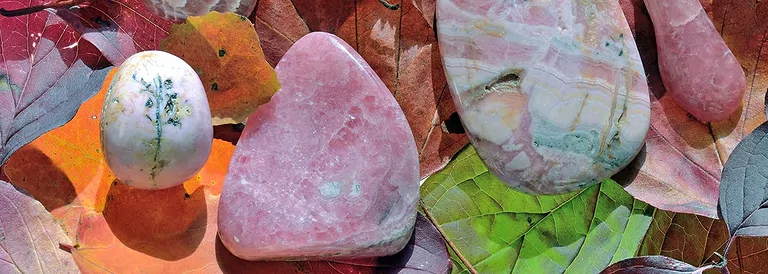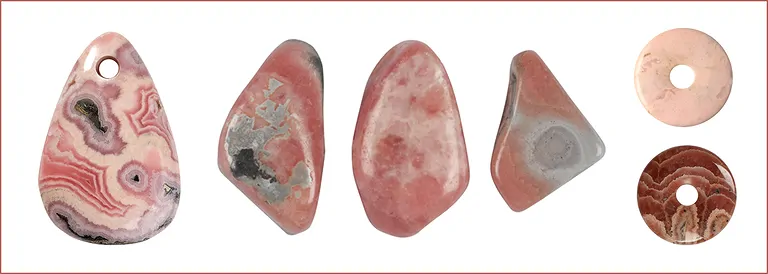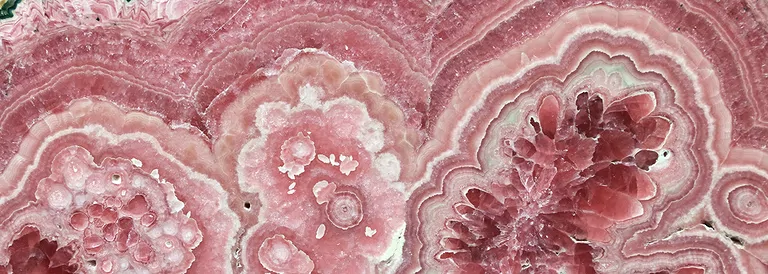
Rhodochrosite - Meaning, effect and application
Rhodochrosite promotes activity and liveliness, so that we can get one last time momentum to then reap and enjoy the harvest. Accruing, necessary work we can do powerfully and with good results. The stone conveys a cheerful lightheartedness and ease, with which we can still drive away the first harbingers of the dark season. Stone medicine also uses the pink stone because of its effect to create alertness, lighten the mood and generally invigorate; the mineral therefore stands for activity, cheerfulness and dynamism.
Tumbled stones, donuts, stringed beads and more rhodochrosite items at wholesale prices

Origin of the name Rhodochrosite
The name Rhodochrosite comes from Greek word rhodochroos = rose colored. It was given to the mineral in 1813 by Johann F. L. Hausmann, however, already a little later by Johann F. A. Breithaupt as "übelklingend and difficult to pronounce" criticized. The latter suggested alternatively the terms rose spar and raspberry spar, Abraham Gottlob Werner the name manganese spar. However, Rhodochrosite has become generally accepted. There are other numerous synonyms, for example, red or air acid brownstone ore, dense redstone, red manganese ore, cobalt manganese spar, incarose or red spar.
The intensity of the color varies greatly. This is determined not only by the proportion of manganese, but also by the size of the crystals or the grain size of the aggregates: the larger they are, the darker the color of the stone. Also important for the color of the mineral are the temperature conditions during formation: thus, intense cherry-red specimens are formed at high temperatures and relatively weak solutions, pale pink and light rhodochrosite is formed at low temperatures and solutions with high content of manganese, iron, calcium and magnesium. At first glance, rhodochrosite can easily be confused with rhodonite because of its color, but it usually has typical banding or concentric, circular aggregates.
Localities and main suppling countries of Rhodochrosite
The most important formation in terms of quantity occurs secondarily in the oxidation zone of manganese ore deposits, where intruding carbonated water with the manganese oxides present causes rhodochrosite to form. In such secondary deposits even large rhodochrosite dripstones can form, e.g. in the former silver mines of the Incas in Argentina, which have been abandoned for 800 years. Rather rarely rhodochrosite originates primarily from hydrothermal solutions (Germany, South Africa, Peru, Colorado/USA) or as tertiary formations by contact metasomatosis.
Worldwide rhodochrosite could be proven so far at about 1400 localities. The type locality is the "Cavnic Mine" in Romania, which is also known for its pink-colored, spherical to kidney-shaped aggregates. Further important Rhodochrosite localities are the "Sweet Home Mine" near Alma (Colorado), where up to 15cm large crystals were found, as well as the South African N'Chwaning Mines near Kuruman and Silverton (Colorado). But also in Germany Rhodochrosite was already found: Site of beautiful crystals was, for example, the mine Wolf in the Siegerland as well as smaller ore mines in the Rheingau.
In the meantime, it is becoming increasingly difficult to get good qualities at reasonable prices. That is why Rhodochrosite belongs to the higher-priced, exclusive stone varieties. Most of the Rhodochrosite, which we offer in a wide variety of products from Tumbled Stone to gemstone strand to pendant, comes from Peru and Argentina. Most of the Rhodochrosite from Peru that is exported to the world comes from the Uchucchacua Mine near Lima, the fifth largest silver mine in the world. The mine has been in operation since colonial times. Beautiful dark red crystals can be found there, grown on a dark manganese-rich skarn matrix characteristic of this type locality. In Argentina, Rhodochrosite is the National Stone or the "State Mineral".
For retailer: jewelry, donuts, tringed beads and more rhodchrosite
Mineralogical profile of Rhodochrosite
Chemical Formula: MnCO3
Mineral Class: Carbonate
Formation: important manganese ore, rearrangement product in the weathering zone of ore deposits, gangue mineral on subvolcanic-hydrothermal veins, Tertiary formation by contact metasomatism
Color: pink, raspberry red
Gloss: vitreous luster, on cleavage surfaces nacreous luster
Crystal system: trigonal
Mohs hardness: 4
Cleavability: perfect, uneven fracture, brittle
Transparency: transparent to opaque
Localities, main supplying countries: Argentina, USA, Mexico, Peru
Appearance: derbaceous, shelly, grapey, rarely in beautiful, dark red crystals

Use and appilcations of Rhodochrosite in gemstone healing
Rhodochrosite is used as jewelry and ornamental stone, rarely also for art objects. Archaeölogical findings of grave goods in ancient Egyptian tombs prove that Rhodochrosite is one of the oldest ornamental stones of the ancient world. Since later manganese oxide or manganese ore was also used for the production of glazes, it can not be excluded that our prehistoric ancestors from Egypt and the Roman Empire repeatedly recovered this mineral as a by-product and then processed accordingly.
Chakra assignment: root chakra
Feng Shui assignment: element fire
The gemstone astrology knows this pink stone as a mineral that supports the vitality and energy of Aries-born and promotes the development of their personality.
Tumbled stones, donuts, stringed beads and more rhodochrosite items at wholesale prices